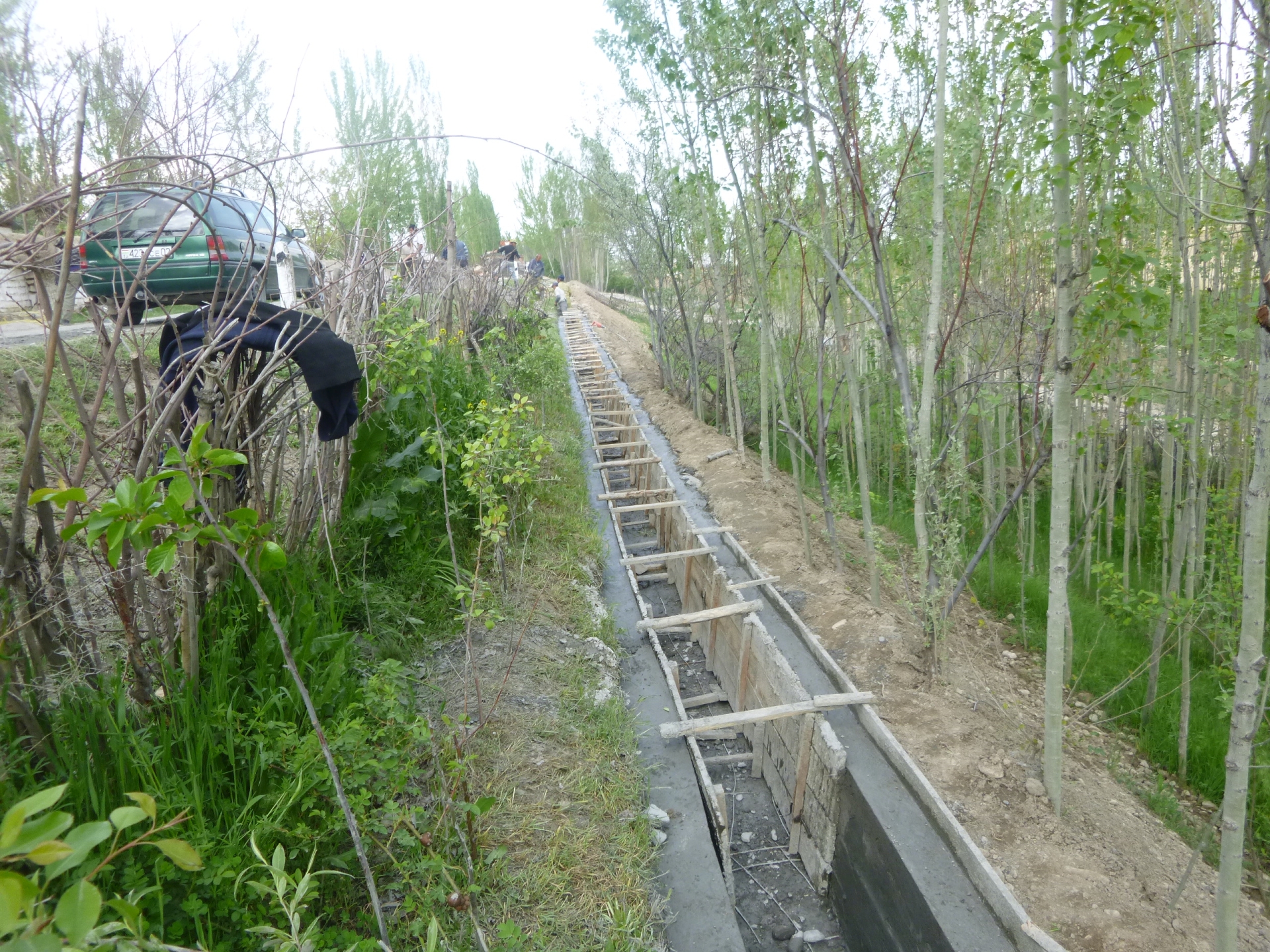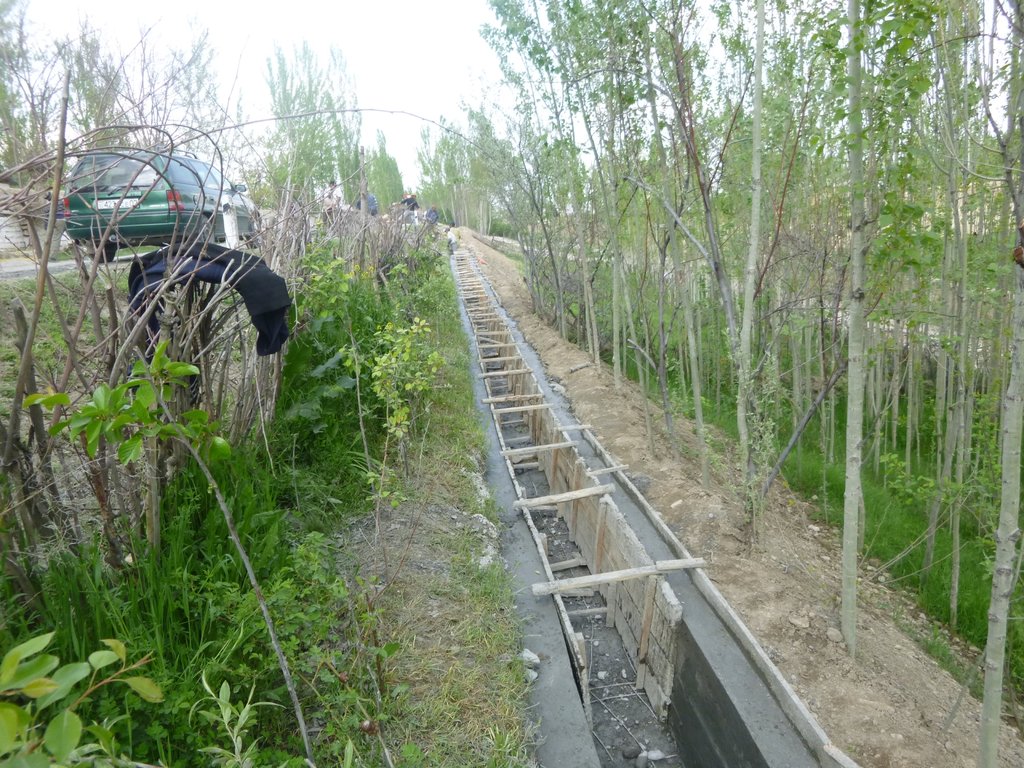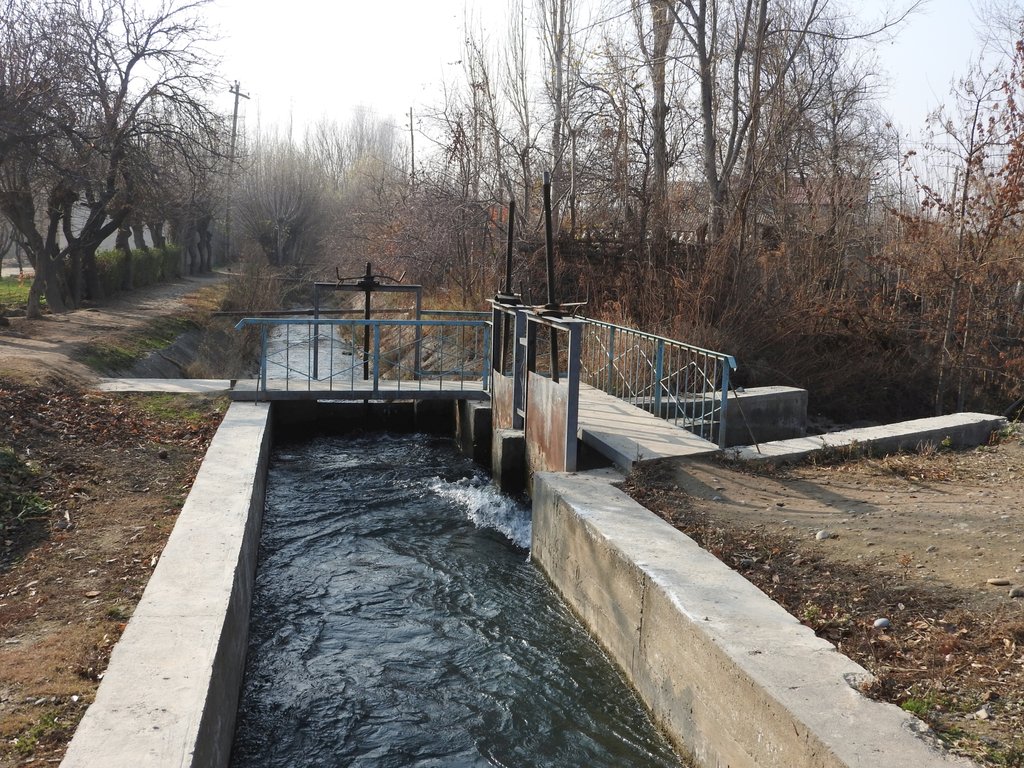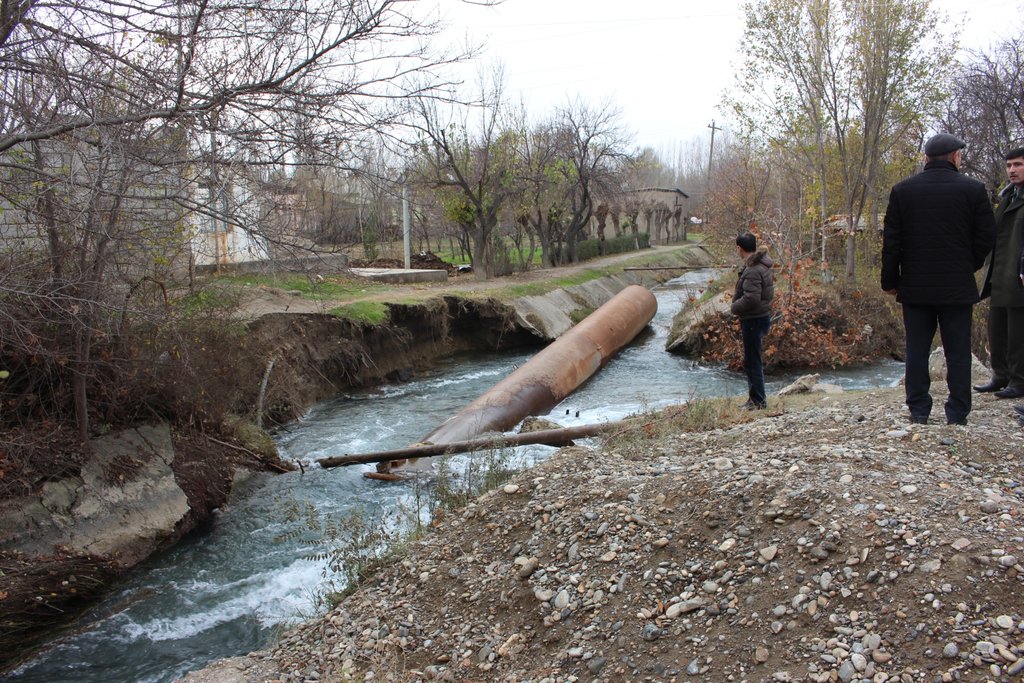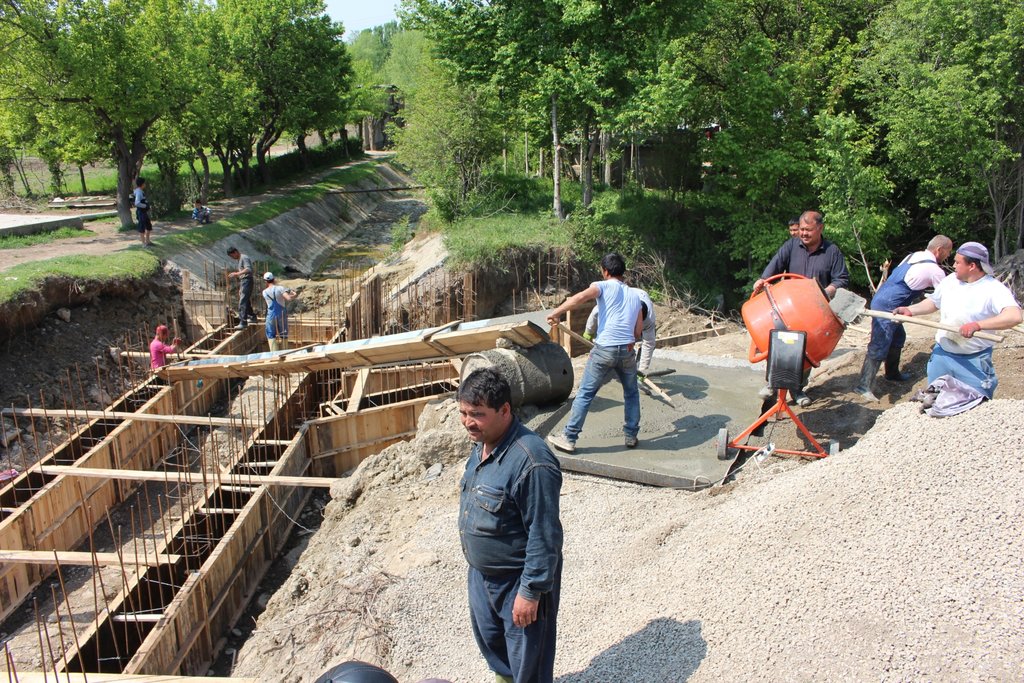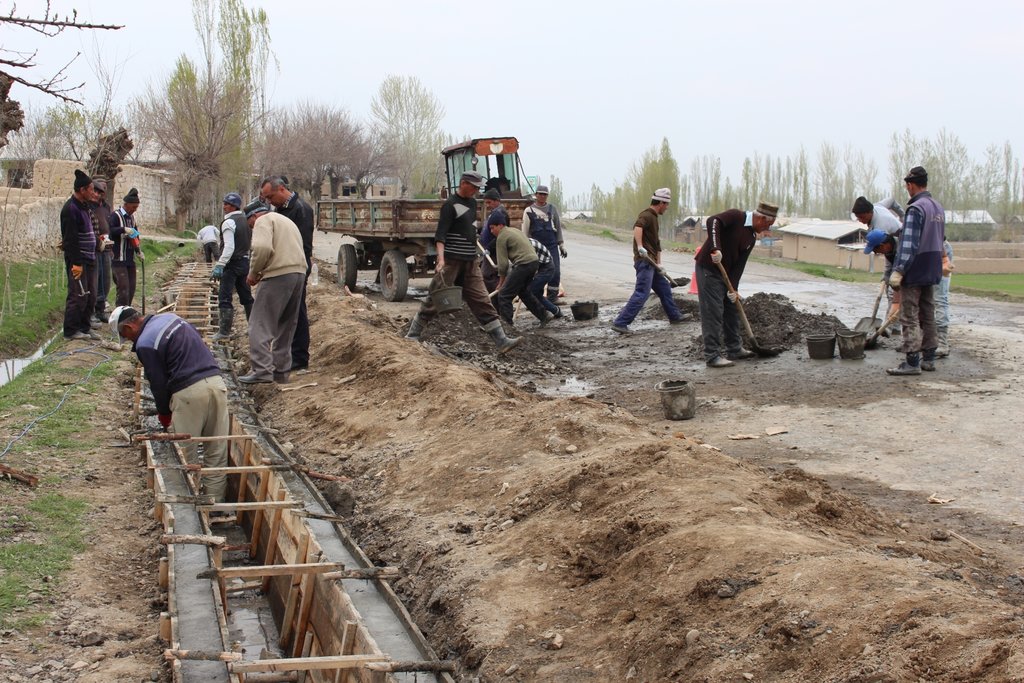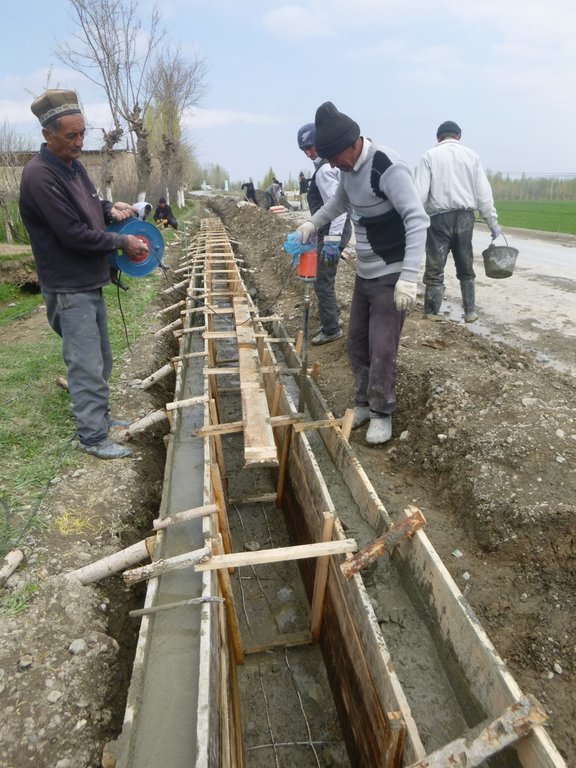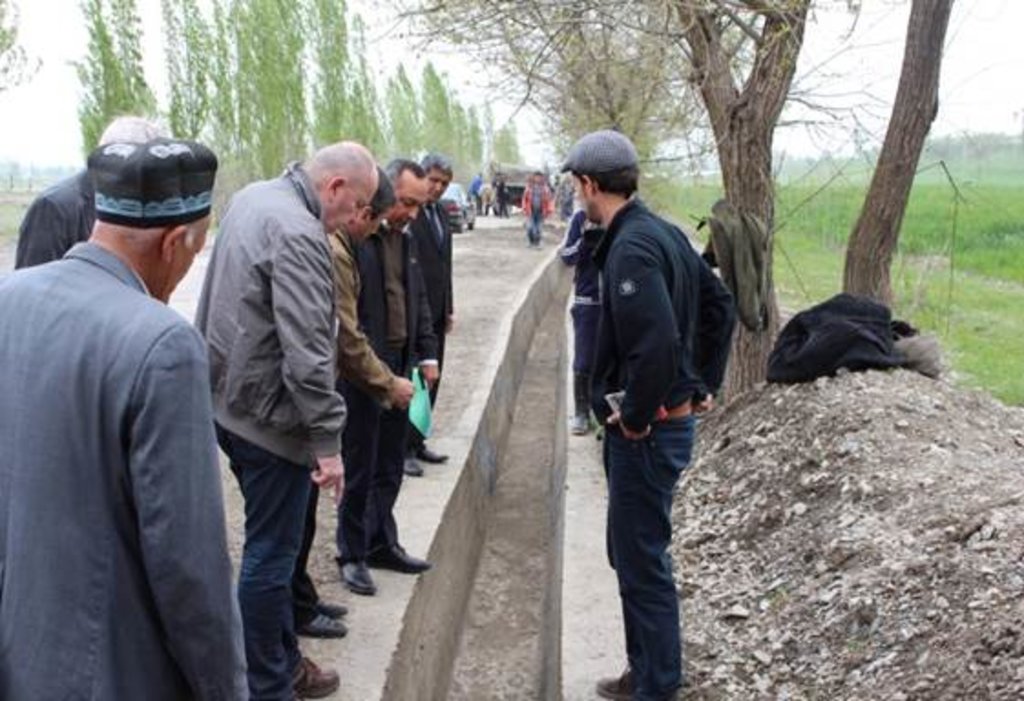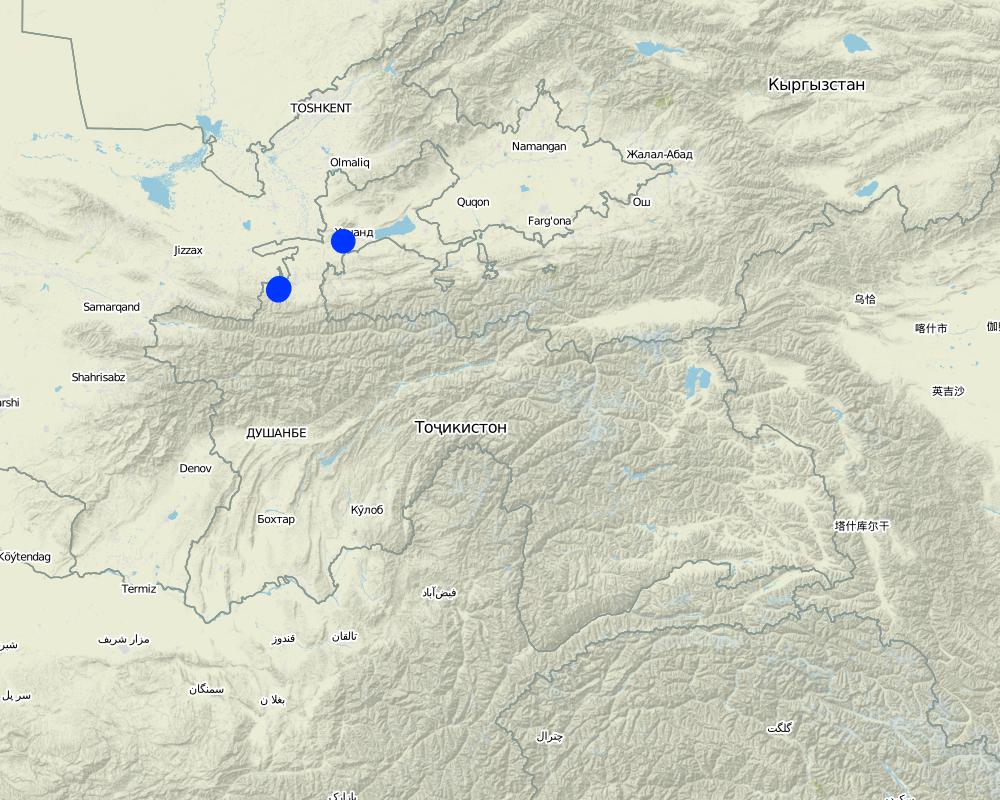Increased efficiency of irrigation water use to address climate change related water shortage [ทาจิกิสถาน]
- ผู้สร้างสรรค์:
- การอัพเดท:
- ผู้รวบรวม: Stefan Michel
- ผู้เรียบเรียง: –
- ผู้ตรวจสอบ: Umed Vahobov
Повышение эффективности использования ирригационной воды для решения проблемы нехватки воды, связанной с изменением климата
approaches_4318 - ทาจิกิสถาน
ดูส่วนย่อย
ขยายทั้งหมด ย่อทั้งหมด1. ข้อมูลทั่วไป
1.2 รายละเอียดที่ติดต่อได้ของผู้รวบรวมและองค์กรที่เกี่ยวข้องในการประเมินและการจัดเตรียมทำเอกสารของแนวทาง
วิทยากรหลัก
ผู้เชี่ยวชาญ SLM:
Negmatov Negmatjon
negmatdzhon.negmatov@giz.de
Deutsche Gesellschaft für Internationale Zusammenarbeit (GIZ)
ทาจิกิสถาน
Muhidinov Nodir
+992 92 777 0134
nodir.sfl@gmail.com
Deutsche Gesellschaft für Internationale Zusammenarbeit (GIZ)
ทาจิกิสถาน
ชื่อของโครงการซึ่งอำนวยความสะดวกในการทำเอกสารหรือการประเมินแนวทาง (ถ้าเกี่ยวข้อง)
Strengthening of Livelihoods through Climate Change Adaptation in Kyrgyzstan and Tajikistanชื่อของโครงการซึ่งอำนวยความสะดวกในการทำเอกสารหรือการประเมินแนวทาง (ถ้าเกี่ยวข้อง)
Deutsche Gesellschaft für Internationale Zusammenarbeit - Tajikistan (GIZ Tajikistan) - ทาจิกิสถาน1.3 เงื่อนไขที่เกี่ยวข้องกับการใช้ข้อมูลที่ได้บันทึกไว้ผ่านทาง WOCAT
วันที่เก็บรวบรวมข้อมูล (ภาคสนาม):
27/11/2018
ผู้รวบรวมและวิทยากรหลักยอมรับเงื่อนไขเกี่ยวกับการใช้ข้อมูลที่ถูกบันทึกผ่านทาง WOCAT:
ใช่
1.4 การอ้างอิงถึงแบบสอบถามเรื่องเทคโนโลยี SLM
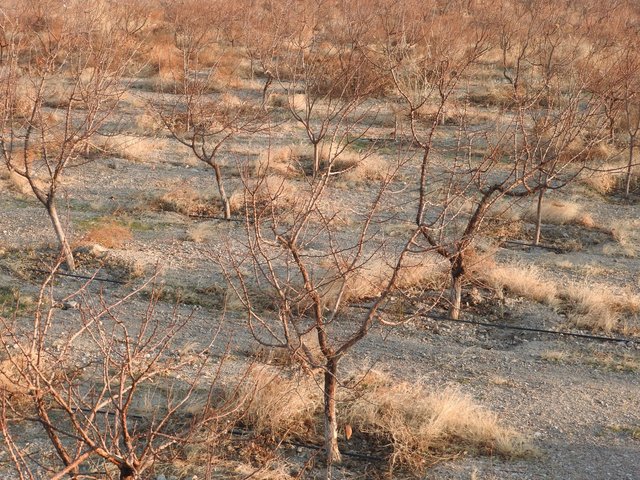
Applying drip irrigation for efficient irrigation water use … [ทาจิกิสถาน]
Drip irrigation substantially saves water compared to conventional furrow irrigation. Here the technology is applied for different perennial and annual crops and with use of different sources of water.
- ผู้รวบรวม: Stefan Michel
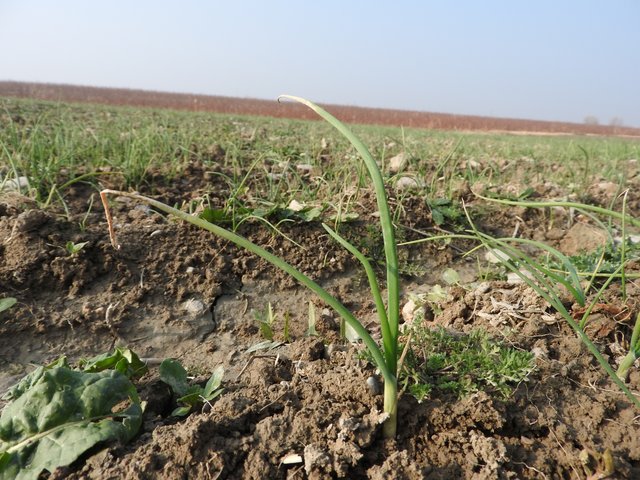
Onion production by greenhouse propagation and transplantation [ทาจิกิสถาน]
Onion seeds are sown in sheeting greenhouses, where the onion seedlings are propagated. The seedlings are then replanted in the open field. This makes them less prone to extreme weather events and provides higher yield of better quality.
- ผู้รวบรวม: Stefan Michel
2. คำอธิบายของแนวทาง SLM
2.1 การอธิบายแบบสั้น ๆ ของแนวทาง
Climate change impact contributes to irrigation water shortage. The approach of improving irrigation water delivery, distribution and use prevents irrigation water losses and increases the productivity per amount of irrigation water available.
2.2 การอธิบายอย่างละเอียดของแนวทาง
การอธิบายอย่างละเอียดของแนวทาง:
Irrigated agriculture is in many areas limited by the availability of irrigation water. In many irrigated areas the canals delivering water to villages, distributing it between farms and the on-farm irrigation systems are in poor shape, which causes substantial water losses. The human population growth further contributes to shortages of irrigation water.
These problems are increasingly exacerbated by the impact of climate change. The already visible trends and predictions show higher levels of aridity, higher temperatures during the vegetation season, reduced overall precipitation in catchment areas, more irregular rainfall patterns, reduced snow packs and accelerated snow melt as well as the loss of glaciers as buffers of water flow. These factors all cause a reduction of available irrigation water, while higher temperatures and expansion of irrigated agriculture – partly also caused by increasing aridity and reduced feasibility of rain-fed farming – lead to higher irrigation water demand.
Additionally the increasing frequency and intensity of flashfloods, debris flows and landslides poses substantial risks to the stability and functioning of irrigation canals and thus to the livelihoods of farmers and food security.
The approach therefore aims at reducing the substantial losses of irrigation water caused be seepage from delivery and distribution canals, structural problems in irrigation systems (diversion weirs) and on-farm irrigation. It also addresses risks caused by flashfloods, debris flows and landslides. The structures between major canals, which are managed by the Water Management Departments, and the individual farms are managed by the administrative communities, the mahalla committees, which represent the inhabitants of one village or a section of a larger village. These institutions are called communal self-governance structures, but are subordinated to the government as they are reporting to te sub-district or jamoat.
For the lining of water delivery and distribution canals, the rehabilitation of associated structures and the proofing against disaster events the project conducted a participatory assessment and planning process in the local communities, but with involvement of the district water and irrigation management authorities. In the result of this process key sections for lining and repair were selected and the project further assisted with technical planning and assistance in form of purchase of materials. The communities would contribute about 28% to 39% of the overall costs, mainly in form of voluntary communal work, the so called hashar as well as in form of construction materials.
The community is also in charge of future operation and maintenance of the rehabilitated and disaster and climate proofed irrigation structures.
2.3 รูปภาพของแนวทาง
2.5 ประเทศ ภูมิภาค หรือสถานที่ตั้งที่ได้นำแนวทางไปใช้
ประเทศ:
ทาจิกิสถาน
ภูมิภาค/รัฐ/จังหวัด: :
Sughd region
ข้อมูลเฉพาะเพิ่มเติมของสถานที่ตั้ง:
Shahriston district, Sughdiyon village and J. Rasulov district, Dehmoi village
Map
×2.6 วันที่เริ่มต้นและสิ้นสุดของแนวทาง
ระบุปีที่เริ่ม:
2015
ถ้าไม่รู้ปีที่แน่นอนให้ประมาณวันที่ที่ริเริ่มใช้แนวทางนี้ :
น้อยกว่า 10 ปี (เร็วๆนี้)
2.7 ประเภทของแนวทาง
- ใช้โครงงานหรือแผนงานเป็นฐาน
2.8 เป้าหมายหรือวัตถุประสงค์หลักของแนวทาง
Reduction of water losses from irrigation systems, improvement of irrigation water availability under conditions of climate change.
2.9 เงื่อนไขที่เอื้ออำนวยหรือเป็นอุปสรรคต่อการนำเทคโนโลยีภายใต้แนวทางนี้ไปปฏิบัติใช้
การมีไว้ให้หรือการเข้าถึงแหล่งการเงินและบริการ
- เป็นอุปสรรค
Without external support insufficient financial resources
การจัดตั้งระดับองค์กร
- เอื้ออำนวย
Existence of community level management of irrigation networks
การร่วมมือหรือการทำงานประสานกันของผู้ลงมือปฏิบัติ
- เอื้ออำนวย
Collaboration between water management authorities and community leaders.
ความรู้เกี่ยวกับ SLM การเข้าถึงการสนับสนุนด้านเทคนิค
- เป็นอุปสรรค
Project assistance required to provide engineering knowledge and skills to community
ปริมาณงานที่ทำได้ กำลังคนที่มีให้
- เอื้ออำนวย
Tradition of voluntary joint work for community needs "hashar"
3. การมีส่วนร่วมและบทบาทของผู้มีส่วนได้ส่วนเสียที่เกี่ยวข้อง
3.1 ผู้มีส่วนได้ส่วนเสียที่เกี่ยวข้องในแนวทางนี้และบทบาท
- ผู้ใช้ที่ดินระดับท้องถิ่นหรือชุมชนระดับท้องถิ่น
Local community members
Participation in identification of sections for rehabilitation/improvement;
Carrying out construction works.
- รัฐบาลระดับท้องถิ่น
Water management department at district level
Mahalla committee
Identification of sections for rehabilitation/improvement
Participation in planning
Organization of community work
- องค์การระหว่างประเทศ
Deutsche Gesellschaft für Internationale Zusammenarbeit (GIZ)
Overall project implementation;
Technical planning and oversight;
Procurement of construction materials via competitive bidding process
ถ้ามีผู้มีส่วนได้ส่วนเสียหลายคนที่เกี่ยวข้องให้ระบุหน่วยงานตัวแทน:
Deutsche Gesellschaft für Internationale Zusammenarbeit (GIZ)
3.2 การเกี่ยวข้องของผู้ใช้ที่ดินระดับท้องถิ่นหรือชุมชนระดับท้องถิ่นในช่วงต่างๆของแนวทาง
| ความเกี่ยวข้องของผู้ใช้ที่ดินระดับท้องถิ่นหรือชุมชนระดับท้องถิ่น | ระบุผู้ที่มีส่วนเกี่ยวข้องและอธิบายกิจกรรม | |
|---|---|---|
| การริเริ่มหรือการจูงใจ | ปฏิสัมพันธ์ | Local community members, indicating problem issues to community leadership, water management department and GIZ staff |
| การวางแผน | ปฏิสัมพันธ์ | Involvement of community members in planning |
| การดำเนินการ | ระดมกำลังด้วยตนเอง | Local community members carrying out works through traditional voluntary community work ("hashar"). |
| การติดตามตรวจสอบหรือการประเมินผล | ปฏิสัมพันธ์ | Local farmers involved in monitoring of water supply. |
3.4 การตัดสินใจเลือกใช้เทคโนโลยี SLM
ระบุผู้ที่ทำการตัดสินใจเลือกเทคโนโลยีมากกว่าหนึ่งวิธีไปปฏิบัติใช้:
- ผู้เชี่ยวชาญ SLM เป็นผู้ตัดสินใจหลัก ที่ติดตามให้คำปรึกษากับผู้ใช้ที่ดิน
การอธิบาย:
Technical aspects decided by specialized engineers taking into consideration the needs and observations of community members.
ระบุว่าการตัดสินใจตั้งอยู่บนพื้นฐานของ:
- การประเมินความรู้ SLM ที่ได้ทำการบันทึกไว้เป็นอย่างดี (การใช้ข้อมูลในการตัดสินใจ)
- ประสบการณ์และความคิดเห็นส่วนตัว (ไม่ได้ลงบันทึกไว้)
4. การสนับสนุนด้านเทคนิค การสร้างขีดความสามารถ และการจัดการด้านความรู้
4.1 การสร้างขีดความสามารถ / การอบรม
ได้มีการจัดอบรมให้แก่ผู้ใช้ที่ดินหรือผู้มีส่วนได้ส่วนเสียคนอื่น ๆ หรือไม่:
ไม่ใช่
4.2 การบริการให้คำแนะนำ
ผู้ใช้ที่ดินมีการเข้าถึงการรับบริการให้คำปรึกษาหรือไม่:
ใช่
ระบุว่ามีบริการให้คำปรึกษาหรือไม่:
- ไปเยี่ยมชมสถานที่
4.3 การเสริมความแข็งแกร่งให้กับสถาบัน (การพัฒนาองค์กร)
สถาบันได้รับการจัดตั้งขึ้นมาหรือเสริมความแข็งแกร่งโดยแนวทางนี้หรือไม่:
- ใช่ ปานกลาง
ระบุระดับของสถาบันที่ได้รับการเสริมความแข็งแกร่งหรือจัดตั้งขึ้นมา:
- ท้องถิ่น
อธิบายถึงสถาบัน บทบาทและความรับผิดชอบ สมาชิก เป็นต้น:
Existing community institutions have been strengthened through joint successful implementation of the works and the need for further maintenance of irrigation system elements as common property.
ระบุประเภทของการให้ความช่วยเหลือสนับสนุน:
- ด้านการเงิน
- อุปกรณ์
4.4 การติดตามตรวจสอบและประเมินผล
การติดตามตรวจสอบและประเมินผลเป็นส่วนหนึ่งของแนวทางหรือไม่:
ใช่
ถ้าตอบว่าใช่ แสดงว่าการจัดเตรียมเอกสารนี้มุ่งหวังที่จะเอาไปใช้สำหรับการติดตามตรวจสอบและประเมินผลใช่หรือไม่:
ไม่ใช่
4.5 การวิจัย
การวิจัยเป็นส่วนหนึ่งของแนวทางหรือไม่:
ไม่ใช่
5. การสนับสนุนด้านการเงินและวัสดุอุปกรณ์
5.1 ระบุงบประมาณประจำปีสำหรับแนวทาง SLM นี้
ระบุงบประมาณประจำปีสำหรับแนวทาง SLM นี้ เป็นหน่วยดอลลาร์สหรัฐ:
60000.00
ถ้าหากว่างบประมาณประจำปีไม่เป็นที่ทราบแน่นอน ให้ระบุช่วงลงไป:
- 10,000-100,000
แสดงความคิดเห็น (แหล่งของการระดมทุน ผู้บริจาคคนสำคัญ):
The number indicates the immediate construction costs of three sites, where the approach was implemented, without costs for facilitation, planning, technical supervision, monitoring and evaluation. The main source of funding was the Government of Germany via GIZ. Communities contributed 28% to 39% in form of labour and locally available construction material.
5.2 การสนับสนุนด้านการเงิน / วัสดุอุปกรณ์ให้แก่ผู้ใช้ที่ดิน
ผู้ใช้ที่ดินได้รับการสนับสนุนด้านการเงิน / วัสดุอุปกรณ์ไปปฏิบัติใช้เทคโนโลยีหรือไม่:
ใช่
ถ้าใช่ ให้ระบุประเภทของการสนับสนุน เงื่อนไขและผู้จัดหามาให้:
Technical planning and supervision, procurement of materials and transportation funded by GIZ.
5.3 เงินสนับสนุนสำหรับปัจจัยนำเข้า (รวมถึงแรงงาน)
- ไม่มี
ถ้าแรงงานโดยผู้ใช้ที่ดินเป็นปัจจัยนำเข้าที่มีอยู่มากมาย ระบุด้วยว่าเนื่องจาก:
- สมัครใจ
5.4 เครดิต
มีการจัดหาเครดิตมาให้ภายใต้แนวทาง SLM หรือไม่:
ไม่ใช่
5.5 แรงจูงใจหรือเครื่องมืออื่น ๆ
แรงจูงใจหรือเครื่องมืออื่น ๆ ได้ถูกนำไปใช้ส่งเสริมการใช้เทคโนโลยี SLM หรือไม่:
ไม่ใช่
6. การวิเคราะห์ผลกระทบและการสรุป
6.1 ผลกระทบของแนวทาง
ทำให้ผู้ใช้ที่ดินระดับท้องถิ่นมีอำนาจขึ้น ปรับปรุงการเข้าร่วมของผู้มีส่วนได้ส่วนเสียให้ดีขึ้นหรือไม่:
- ไม่ใช่
- ใช่ เล็กน้อย
- ใช่ ปานกลาง
- ใช่ อย่างมาก
Mobilization for joint work ti address problems affecting all farmers/community members
ช่วยให้ผู้ใช้ที่ดินนำเอาเทคโนโลยี SLMไปใช้และบำรุงรักษาสภาพไว้ได้หรือไม่:
- ไม่ใช่
- ใช่ เล็กน้อย
- ใช่ ปานกลาง
- ใช่ อย่างมาก
Construction and maintenance of irrigation systems of higher efficiency with reduced water losses and risk of disaster impact.
ปรับปรุงความร่วมมือกันและการดำเนิน งานของ SLM ได้อย่างมีประสิทธิผลหรือไม่:
- ไม่ใช่
- ใช่ เล็กน้อย
- ใช่ ปานกลาง
- ใช่ อย่างมาก
Coordination between donor, district level water management department, community leadership and community members
ระดมกำลังหรือปรับปรุงการเข้าถึงแหล่ง เงินทุนสำหรับการดำเนินการ SLM หรือไม่:
- ไม่ใช่
- ใช่ เล็กน้อย
- ใช่ ปานกลาง
- ใช่ อย่างมาก
Mobilization of own resources in the community and of donor funding.
ปรับปรุงความรู้และความสามารถของผู้ใช้ที่ดินในการดำเนินการ SLM หรือไม่:
- ไม่ใช่
- ใช่ เล็กน้อย
- ใช่ ปานกลาง
- ใช่ อย่างมาก
Improved technical knowledge on construction of irrigation systems minimizing water losses and reducing disaster risk.
ปรับปรุงความรู้และความสามารถของผู้มีส่วนได้ส่วนเสียคนอื่น ๆ ให้ดีขึ้นหรือไม่:
- ไม่ใช่
- ใช่ เล็กน้อย
- ใช่ ปานกลาง
- ใช่ อย่างมาก
Community leadership and district level water management department - improved technical knowledge on construction of irrigation systems minimizing water losses and reducing disaster risk.
ทำให้ผู้ใช้ที่ดินระดับท้องถิ่นมีอำนาจขึ้น ปรับปรุงการเข้าร่วมของผู้มีส่วนได้ส่วนเสียให้ดีขึ้นหรือไม่:
- ไม่ใช่
- ใช่ เล็กน้อย
- ใช่ ปานกลาง
- ใช่ อย่างมาก
Coordination between donor, district level water management department, community leadership and community members
ช่วยบรรเทาความขัดแย้งหรือไม่:
- ไม่ใช่
- ใช่ เล็กน้อย
- ใช่ ปานกลาง
- ใช่ อย่างมาก
More efficient water delivery and distribution reduces conflict about access to irrigation water within the community and between villages.
ทำให้กลุ่มด้อยโอกาสมีอำนาจทางสังคมและเศรษฐกิจหรือไม่:
- ไม่ใช่
- ใช่ เล็กน้อย
- ใช่ ปานกลาง
- ใช่ อย่างมาก
Mobilization of all community members to contribute to activities with common benefits.
ส่งเสริมให้เยาวชนหรือบุตรหลานของผู้ใช้ที่ดินให้เข้าร่วมใน SLM:
- ไม่ใช่
- ใช่ เล็กน้อย
- ใช่ ปานกลาง
- ใช่ อย่างมาก
Mobilization of all community members to contribute to activities with common benefits.
นำไปสู่ความมั่นคงด้านอาหารหรือปรับปรุงโภชนาการให้ดีขึ้น:
- ไม่ใช่
- ใช่ เล็กน้อย
- ใช่ ปานกลาง
- ใช่ อย่างมาก
Reduced shortage of irrigation water and reduced risk of failure of irrigation systems due to disasters led to secure yields in irrigated agriculture and improved food security.
นำไปสู่การเข้าถึงเรื่องน้ำและสุขาภิบาลได้ดีขึ้นหรือไม่:
- ไม่ใช่
- ใช่ เล็กน้อย
- ใช่ ปานกลาง
- ใช่ อย่างมาก
Water from irrigation canals is partly also used for household needs.
ปรับปรุงความสามารถของผู้ใช้ที่ดินในการปรับตัวให้เข้ากับการเปลี่ยนแปลงของสภาพภูมิอากาศหรือสภาพที่รุนแรงและภัยพิบัติหรือไม่:
- ไม่ใช่
- ใช่ เล็กน้อย
- ใช่ ปานกลาง
- ใช่ อย่างมาก
Increased resilience to climate change related irrigation water shortage by improved efficiency of water delivery and distribution; Reduced proneness of irrigation system to natural disaster, the frequency and intensity of which is increasing due to climate change.
นำไปสู่โอกาสในการจ้างงาน รายได้หรือไม่:
- ไม่ใช่
- ใช่ เล็กน้อย
- ใช่ ปานกลาง
- ใช่ อย่างมาก
Indirectly by providing secure access to sufficient irrigation water for farming.
6.2 แรงจูงใจหลักของผู้ใช้ที่ดินเพื่อที่จะนำ SLM ไปปฏิบัติใช้
- การผลิตที่เพิ่มขึ้น
Sufficient water available for irrigated agriculture
- ความเสี่ยงของภัยพิบัติลดลง
Proneness of irrigation system to flashfloods, debris flows and similar events.
- การบรรเทาด้านความขัดแย้ง
Reduced conflict over access to irrigation water.
6.3 ความยั่งยืนของกิจกรรมของแนวทาง
ผู้ใช้ที่ดินสามารถทำให้สิ่งต่างๆ ที่ได้ปฏิบัติใช้โดยแนวทางนี้ยั่งยืนได้หรือไม่ (โดยไม่มีการสนับสนุนจากภายนอก):
- ใช่
ถ้าตอบว่าใช่ ให้อธิบายว่าอย่างไร :
Maintenance of irrigation systems through contributions of all water users and join voluntary work ("hashar").
6.4 จุดแข็งและข้อได้เปรียบของแนวทาง
| จุดแข็ง / ข้อได้เปรียบของแนวทางในทัศนคติของผู้ใช้ที่ดิน |
|---|
| Access to technology and materials, which would not affordably without external support. |
| Secure and sufficient supply of irrigation water. |
| Reduced risk of failure of irrigation system caused by natural disaster during critical times (irrigation period). |
| จุดแข็ง / ข้อได้เปรียบของแนวทางในทัศนคติของผู้รวบรวมหรือวิทยากรหลัก |
|---|
| Same as land users' perspective. |
| Mobilization of resources of the land users and their community. |
| Strengthening of collaboration between district level water management departments, community leadership and community members. |
6.5 จุดอ่อน / ข้อเสียเปรียบของแนวทางและวิธีในการแก้ไข
| จุดอ่อน / ข้อเสียเปรียบในทัศนคติของผู้ใช้ที่ดิน | สามารถแก้ไขปัญหาได้อย่างไร |
|---|---|
| None |
| จุดอ่อน / ข้อเสียเปรียบในทัศนคติของผู้รวบรวมหรือวิทยากรหลัก | สามารถแก้ไขปัญหาได้อย่างไร |
|---|---|
| None |
7. การอ้างอิงและการเชื่อมต่อ
7.1 วิธีการหรือแหล่งข้อมูล
- ไปเยี่ยมชมภาคสนาม การสำรวจพื้นที่ภาคสนาม
- การสัมภาษณ์ผู้เชี่ยวชาญด้าน SLM หรือผู้ชำนาญ
ลิงก์และโมดูล
ขยายทั้งหมด ย่อทั้งหมดลิงก์

Applying drip irrigation for efficient irrigation water use … [ทาจิกิสถาน]
Drip irrigation substantially saves water compared to conventional furrow irrigation. Here the technology is applied for different perennial and annual crops and with use of different sources of water.
- ผู้รวบรวม: Stefan Michel

Onion production by greenhouse propagation and transplantation [ทาจิกิสถาน]
Onion seeds are sown in sheeting greenhouses, where the onion seedlings are propagated. The seedlings are then replanted in the open field. This makes them less prone to extreme weather events and provides higher yield of better quality.
- ผู้รวบรวม: Stefan Michel
โมดูล
ไม่มีโมดูล


